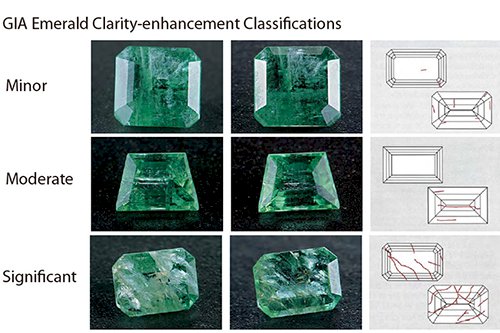Guide to Buying and Treating Emeralds
How to buy and treat your emeralds.

How to buy and tell the difference between a 100% natural emerald, without oil, with minor, moderate and significant treatment.
Knowing the difference between a natural, oil-free emerald or one that has been tattooed with oil, resin or dye is a very important skill that any emerald buyer should know before buying an emerald.
Depending on the level of treatment and / or type of treatment, there are significant different price ranges, as the treatment provides clues as to the rarity of a particular emerald.
For example, a top quality emerald of more than 5 carats that is not treated (without oil or resin) can reach prices above US $ 50,000 per carat!
However, lower quality emeralds that have been “significantly” treated with oil, dye and resin can be priced at around $ 10 per carat!
Therefore, understanding how to identify and verify the authenticity of the certificate can make the difference between buying a top quality emerald or buying a gemstone that you have been cheated on, as the seller may not have informed you what type of treatment the stones have had and how the stone was treated.
I hope that this guide provides a basic understanding of how to distinguish different types of treatments.
I want to emphasize that even if you read this guide thoroughly and understand the basics, it takes years of experience with emeralds to really understand and distinguish different treatments. If there is any doubt in your purchase, even if it is a 1% chance, it is always best to check the stone at a reliable gemstone laboratory or with an experienced and reliable dealer.
Emeralds in General
Almost all emeralds are generally treated with fillers such as oil, resin or a combination of multiple substances. Commerce estimates that more than 99% of emeralds have some treatment.
In terms of hardness, the emerald crystal itself is relatively hard, but it is softer compared to other colored gemstones such as rubies, sapphires and diamonds.
The emerald crystal has a mohs hardness scale of about 7.5 to 8.0. However, almost all emeralds have some inclusions or fractures, because this is how crystals are naturally formed, along with the harsh techniques used in mining them.
This is the reason why GIA classified them as Type III gemstones, which are considered to be naturally colored gems that are "naturally with inclusions". So, please don't give up if you see an emerald with inclusions in it.
In addition, the whole process of how emeralds come from the raw product to the final product does not allow it to be “untreated” with oil or resin.
When the raw emeralds are extracted, almost "all" are immediately thrown into a barrel of oil. When cutting them, the cutter will keep the oil to lubricate it.
Finally, when the merchant or wholesaler wants to sell it, they will dip the emeralds again in oil or other substances.
They can use the colorless type (commercially accepted) or improved color oil (not accepted) or resin (almost impossible to remove) to improve clarity and therefore “can” suggest a higher price than treated stone “less ”Original. So, now you know why almost all emeralds are treated!
It is also important to remember that, after purchasing an emerald, always be careful when sending it to the jeweler or to the cleaners who use ultrasound or steam to clean the stone. Ultrasonic vibrations can weaken the emeralds that are already fractured and the hot steam can cause the oil or the hardened resin to sweat the surface fractures. Therefore, rubbing gently with warm, soapy water is the safest way to clean emeralds.
Oil-free, resin-free, 100% natural emerald
Natural emeralds that are not treated are 'rare' and as you read above, it sets astronomical prices!
So, how do you know if your emerald has no oil or resin? In fact, it is very simple! Just find one that has no fractures on the surface, so that no oil can get into the crystal or stone!
This will ensure that the emerald is oil-free because the crystal itself is clear or protected (without fractures reaching the surface), so there is no chance of any “foreign” substance entering the stone.
To check this, you should use natural daylight (or light tube) or natural sunlight and tilt the emerald at such an angle that the light reflects off the stone's surface (the reflected surface looks white).
Then, with your microscope (or magnifying glass although it is a little more difficult) you can see if there are dark lines or indented lines on this reflective surface and if it does, it indicates that there are some fractures reaching the surface and therefore almost 100% likely that some strange substance has entered the emerald.

The area highlighted in yellow shows the reflective light and the dark line, which proves that this emerald has fractures reaching the surface. This emerald probably has a strange substance in the stone.
However, if you don't see anything, anywhere and in all facets, then you can have one of the rarest gems in front of you!

Example of an emerald that has no "oil, resin or any foreign substance", as there is no fracture reaching the surface of the stone.
So, if you come across an emerald that has no oil, resin or any treatment and that has a clean crystal, you should sit down and “save” the image of it, because they are exceptionally rare and finding a replacement with these characteristics is almost impossible!
Smaller, Moderate or Significant Treated Emeralds
Distinguishing between different levels of treatment in emeralds is a very difficult task and requires time and sophisticated equipment to tell what type of fill exists in an emerald. As explained above, most emeralds are treated multiple times and therefore are likely to have several types of fillers in them.
However, if you have a microscope with dark field illumination (and fiber optic light), you can usually see the presence or absence of fill, tilting the emerald back and forth from the front and side view and looking for some “flashes” visible colors ”.
Again, you should check these flashes along the cracks that hit the surface of the emerald (the process for finding these cracks on the surface is explained in the section above.

The substance filler flashes orange in this image.
If you see this, you know that this emerald has some strange substance in it. Again, this will not specify the type of padding, but it will let you know if there is a padding present or not.
Another way to detect the presence of padding is to check the emerald under fluorescent light and look for foreign material to fluoresce (only sometimes). However, not all emerald fillers flash or shine, so again, this is not a 100% reliable test.
Then, the next step after checking the clues above, trained gemologists start looking for fillings inside the emerald. This skill requires some training and experience, as it is very difficult to distinguish between fillers from natural liquid inclusions.
Inclusions in natural emeralds include the following characteristics:
Liquid-filled inclusions
Fingerprints
Biphasic and three-phase inclusions
Angular growth zoning
Tube and needle-like inclusions
Mineral inclusions including pyrite crystals, calcite inclusions along fractures and biotite flakes
Inclusions of fracture-filled emeralds look like:
Flash effect of various colors, such as orange for pinkish purple flash, blue flash or yellow-orange for blue flash.
The oil may have a slightly yellow or brownish color (be careful not to confuse this color with the oxide color in fractures)
Decomposed oils can leave whitish or yellowish patterns
You can see bubbles stuck in the filling material, in the flow structure or in cloudy, whitish and textured areas.

Inclusion of the gas bubble seen next to natural inclusions of emeralds. Proof filling substance inside the emerald.
How do laboratories classify emerald filling as “minor, moderate or significant”?
There was a study done by GIA in 1999, explaining its process of standardizing the amount of filling inside emeralds as a smaller, moderate or significant filling.
What they concluded was that it was easier to standardize this inspection process, classifying the treatment into three categories and making it similar to the diamond classification system, as is understood by most parties - gemologist, traders and final consumers.
Then, when GIA gemologists check the emeralds in the laboratory, they rate the amount of filling inside the emeralds, as described below:
1) Minor - if the presence of cracks filled with substances that fit in VVS2 to VS2 diamond clarity band (again this clarity band is for the amount of substance filled inside the emerald and not clarity of the stone) .. substance filled within the emerald and thus the foreign substance does not alter the clarity of the emerald in a significant amount.
2) Moderate - if the presence of filled cracks corresponds to the diamond light range SI1 to SI2.
3) Significant - if the presence of filled cracks corresponds below the I1 diamond's brightness range.

Improvement of clarity as classified by the GIA. These images were taken from the report published by Gems & Gemology Winter 1999.
Again, the above criteria do not mean that emeralds are less or more included, but only declare how much foreign substance has "disappeared" within the emerald crystal. To clearly understand these, please see the image above provided by GIA.
Our recommendation:
When buying an emerald, it is very important to check how much of the stone has been treated, as this will affect the price of the stone. If you are buying an emerald that is not very expensive, perhaps obtaining a verification certificate from the above laboratories (GIA or GRS) could increase the price a lot. However, if you want to purchase an emerald that does not contain “oil or resin” or that has “smaller oils or resin”, which requires a much higher price in general, consider getting these emeralds certified by these laboratories that specify the amount of treatment seen on the emerald. We also recommend that, for any emerald purchased, you have a third party certificate provided with the stone - that is, AIGS or GIT.
We also recommend buying less expensive emeralds to ask the seller or dealer specific questions about treatments and watch how they respond. If they really know what they are talking about in terms of knowing what kind of treatment or not knowing exactly what treatment is within that particular emerald, but bring up similar talking points, as shown above, then you know that the person you are dealing with is genuine or knowledgeable and therefore, the emerald you are getting is likely to be very accurate as well. However, if the person you buy claims that their emeralds are untreated and 100% natural and have never been treated, they do not know what they are talking about or are not reliable and therefore we advise you to step carefully with these people or avoid dealing with them completely.


